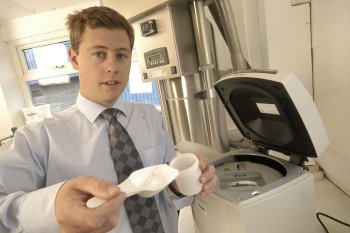James Kent (Ceramic Materials) Ltd had relied for many years on a manual mixing system for their research and quality control of specialist glass powders, but embarked on a search for a process solution that would be more effective, more consistent, quicker and simpler. The glass powders produced by James Kent Ltd are tailored to customer need – primarily for dental fillers and restorers, they vary from 0.5 to 10 microns average particle size. For testing purposes the glass powder needs to be mixed with a high viscosity acrylic resin monomer to check for high transparency and low discolouration – but the manual process, while well understood, continued to give problems of non-homogeneity and air inclusion, both of which preclude colour checking of the glass.
The search for an improved system led Dr Philip Frampton to the Thinky ARE-250, which incorporates both planetary mixing and centrifugal degassing in one unit.
Tests with the Thinky equipment involved mixing 60% glass with 40% acrylic by weight in viscosities varying from “thick honey to stiff bubble gum,” according to Dr Frampton. Empirical investigation supported by our advice rapidly determined suitable program parameters based on viscosity and these samples were then pressed and cured into standard £2 coin sized discs for comparison with established colour standards.
Dr Frampton explained “James Kent are one of probably only 4 or 5 companies in the world operating at the top level in this technology and we were looking to improve the mixing stage as a first step to overall improvement of our glass grinding process. Intertronic’s expertise and supply of the Thinky mixer has allowed us to achieve that initial goal in a single operation – so now we have a reliable quality control process we can move to purchase of a spectro-photometer. This will enable us to refine our operation further toward development of an even cleaner and finer grinding process.”
The mixing of glass and ceramic powders into resins is a perfect job for a Thinky mixer!

Categories: adhesives, case study, glass, mixing
